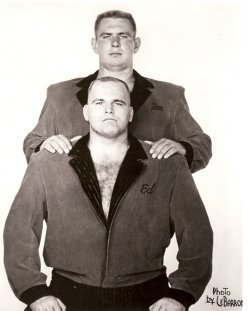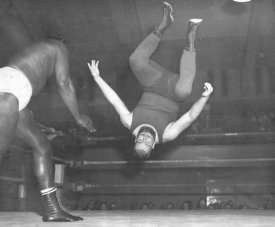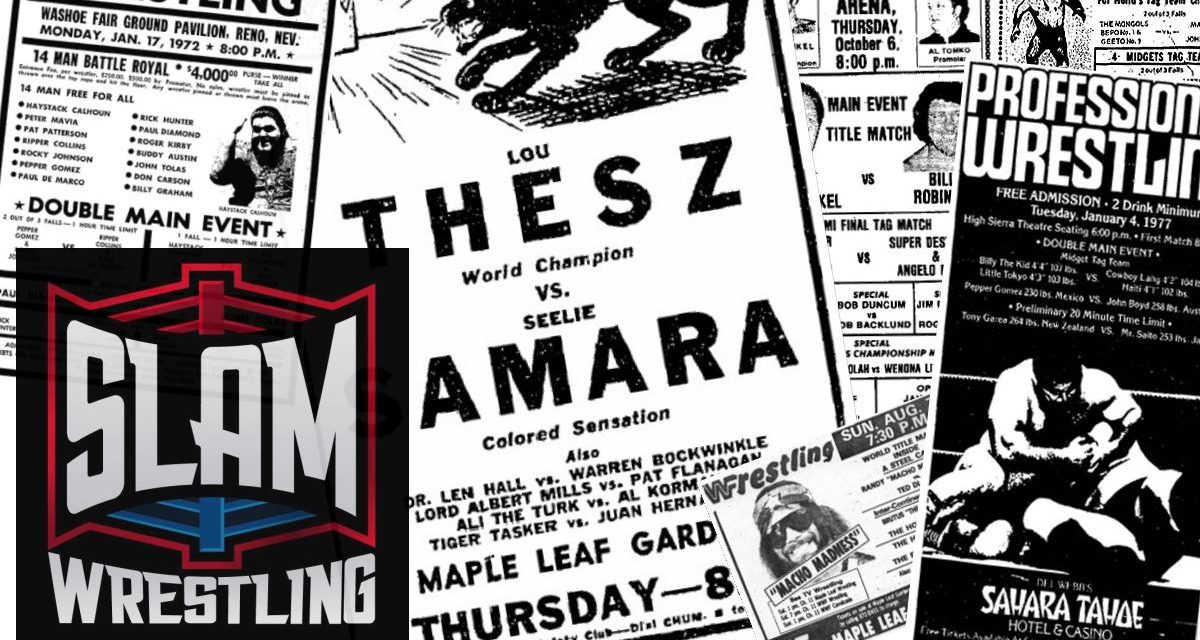As a young adult, Ed Albers heard from people on occasion — including his parents — that he looked an awful lot like “Big” Bill Miller, the champion wrestler. Fast-forward a few years and through some interesting twists of fate (was he actually the model for Mr. Clean?), and Miller is on the phone to Albers, offering him a chance to become his “brother” for tag team matches.
It was a bit of a leap of faith, requiring Albers to disavow his German gimmick as Karl Von Albers, shaving off his mustache and putting away his monocle, and pulling his 35-foot trailer from Montreal all the way to California, where his new partner was stationed with the San Francisco booking office.
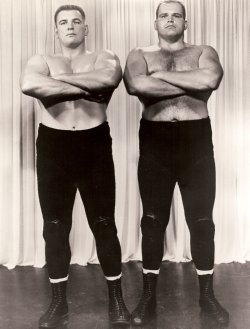
Big Bill Miller and his even bigger “brother” Ed Albers.
The new Millers team stayed in California for the second half of 1956, winning the area’s tag titles.
In early 1957, they were off north to work out of the Toronto office, where they were Canadian Open tag champs. The Globe & Mail newspaper warned that “the Millers are big as redwoods and rough as they come.” Frank Ayerst, who was promoter Frank Tunney’s publicist, ballyhooed the Millers in a newspaper column: “The dictionary is most enlightening in defining the word ‘Miller.’ It says one who grinds into small particles; one who pulverizes; also a well-known type of insect. See, even Webster, with all his erudition, didn’t like them either, and didn’t hesitate to make a crack about them. The Miller Brothers are composed of Big Bill and Ed, who, in turn, are composed of granite with mean streaks running through it. Big Bill is so-called because he weighs 290 pounds. Ed is just called plain Ed, although he weighs 300 pounds. Bill used to cheat about eating his pablum, and hardly grew at all one day.”
From his home in San Jose, California, many, many years retired from the wrestling game, Albers can only laugh at the talk of his toughness — especially in comparison to Bill Miller.
“I’m not a tough guy. I admitted it right at the beginning. I said, ‘Hey, if we get in a fight, I’m going to run,'” he chuckled, launching into a lengthy story.
He and Bill were on the road back to Buffalo, working for Pedro Martinez’s office, when a carload of guys tried to run them off the highway. With the real Miller at the wheel, he vowed to get the punks, and ignored Albers’ pleas to let it drop.
“He pulls in to a restaurant parking lot off the highway. The guys made a terrible mistake — they pulled in behind us and blocked us off, because they were going to take care of us. It was a carload of ’em. Bill said, ‘Let’s get ’em!’ He jumped out of the car, I jumped out of the car. By the time I got around our car to their car to pitch in, Bill was inside the car, beating the hell out of everybody,” recalled Albers. As well, Miller broke off part of the car and starting causing further damage. “Well, the Mounties came. Fortunately, they found beer bottles in the other car — we threw all our beer bottles out before they caught us.”
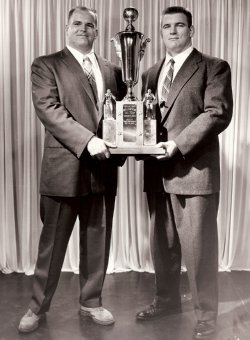
Ed and Bill Miller, championship calibre.
The Toronto bookings meant excellent exposure on Canadian television, and the Millers found themselves in demand across the country. The start of Albers’ “break” with Miller came in Calgary.
“I had decided I would break an ankle, so I did. Teach ya for a big guy to jump off the top of the ring and not do it right,” Albers explained of the 1957 injury. A stretcher was brought out to get the big man out of the arena. “The wonderful fans there in Calgary were punching at me as I was getting rolled out.”
At the time, Miller’s legitimate brother, Danny, was breaking into the business, so naturally the call went out to him to join the team. Ironically, like Albers, Miller was working in Montreal at the time.
With Albers at ringside on crutches, the Millers were a nasty threesome, with Danny decidedly the baby brother.
“[I was] six-foot, 200 pounds when I started,” chuckled Danny Miller. “They were about 6′ 6″, 6′ 5″, and 275, 300 pounds.”
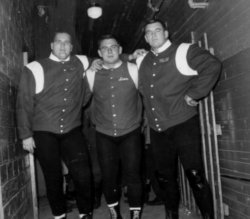
Danny Miller, center, joins Ed and Bill Miller. Terry Dart Collection
Though Ed would team with the real Miller brothers a little in the next couple of years, it was never for any real length of time, and Albers had seen the writing on the wall, and was planning an exit from professional wrestling.
“They looked more alike than I did. At least they had more hair,” joked the bald-headed behemoth.
“[It] was not a bad split up, we just said, ‘Hey, maybe we’d better be doing other things,'” said Albers.
On the subject of lookalikes, however, requires a discussion of the Mr. Clean product, and its famed logo of a beefed-up, bald man, a twinkle in his eye in his white T-shirt.
Albers was working as Karl von Albers, a member of “Nature Boy” Buddy Rogers’ clan of trusted touring pros, in New York City, when he was asked to participate in a photo shoot. Various legal issues require him to tap dance around the subject.
“Yeah, I won’t say yes now, but I’ll tell you what I did pose for. Back in those days, there being no instant stuff, they did motion studies,” he said. “I was in pretty good shape then. I was bald-headed. I posed as a Mr. Clean-type character, because they had me fold my arms as they took pictures and the whole thing. So I said that’s my claim to fame. Oh, and I got $500 bucks for it — now that’s big money!”
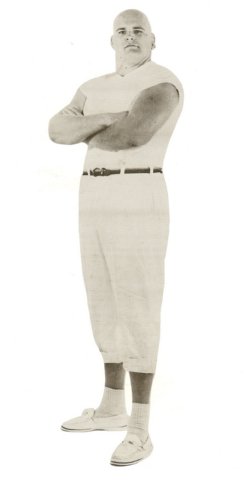
Ed Albers as Mr. Kleen.
Logically, Albers tried to capitalize, and wrestled as Mr. Clean for a while, though the spelling may have varied.
“There must have been 50 of them. … I was Mr. Kleen. I went down to Texas as Mr. Kleen,” said Albers, who had hired a midget named Andy Moore to be “Handy Andy,” which was another cleaning product.
“We were Mr. Kleen and Handy Andy. We had talked about he and I going around the country together, but it didn’t work for him. But when I got the opportunity to go back to San Jose, California, I took that opportunity,” Albers said.
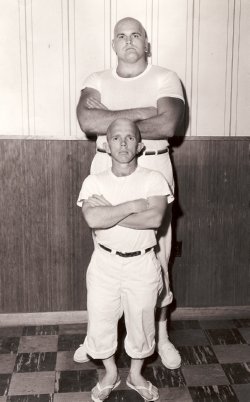
Mr. Kleen and Handy Andy.
“Eventually, I used the Mr. Kleen gimmick. Joe Malcewicz was the promoter in San Francisco. I was kind of getting on top of things. Proctor & Gamble sent a threatening letter to me and to Joe about using their trademark, Mr. Clean. Well, I told Joe, ‘Hey, Joe, I don’t spell it the same way.’ Besides that, though, they were going to sue us for a million dollars. And I said, ‘Hey Joe, what difference does it make? Look at all this publicity that we get here. We’ll pack Kezar Pavilion’ — we didn’t use the Cow Palace at that time — ‘every night.’ He said, ‘No, no, it’s a million dollars.’ I said, ‘I don’t have a dime!’ He said, ‘Kid, I’ve got a million.’ (laughs) Guess what? Mr. Kleen changed to Mr. Dirty. I got myself a little Derby hat, got rid of the white clothes, put on black clothes. It was not a good gimmick, so it failed. Then I was back to being a Miller there for a while.”
In the beginning, Ed Albers, born September 23, 1931 in Cincinnati, Ohio, was a big boy. “Big, sometimes out of shape, which was my cross to bear for a long, long time,” he confessed. Academically unable to play high school football, he fell in with the YMCA wrestling team as a heavyweight.
One night, he was caught trying to sneak into the circus. The old grappler took pity on him and let him in to watch the athletic show, where the touring wrestlers would take on local wannabes, or work fixed matches. “He turned out to be one of the local guys that supposedly was challenging the shooter from the circus. I stayed for that — it cost an extra 25 cents,” said Albers.
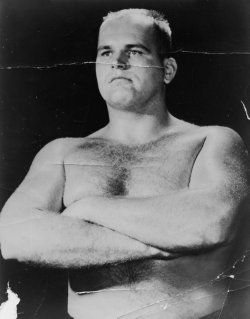
Just Ed Miller.
Before Albers would head to Columbus, Ohio, where the promoter, Al Haft, had a gym and trained wrestlers, the 19-year-old would join the Marine Corps. In 1951, Albers was on the Camp Lejeune wrestling team, and then the USMC wrestling team. “My greatest effort there was Pacific Fleet champion in the heavyweight — actually the dreadnaught class. The big, big guys,” he reminisced.
With Korean War winding down, Albes never saw combat. Sgt. Albers was a truck driver, stationed at Camp Jejeune, North Carolina.
Having served the required active duty, and knowing he was on reserve status for four years, Albers headed to Columbus. Most of his training came under George Macricostas, who was known as the Golden Greek around Ohio.
“You got yourself down to the gym, you start working out, you work different things, and try to develop the holds and things like that, what you’re going to be and how you’re going to be it,” Albers said about the training.
Albers’ training partner ended up doing okay for himself — it was Dick Beyer, better known as The Destroyer, a Hall of Fame star and a Japanese icon. They had an early match together on TV that Albers still cringes over. “We were horrible — I was horrible, Dick is always good. We didn’t do the finish and the whole thing, and they finally almost got a hook out to get us out of there.”
He was Ed Albers from Cincinnati initially, and promoters played up his service in the Marines.
But then he betrayed his country and became Karl von Albers, from Nazi Germany.
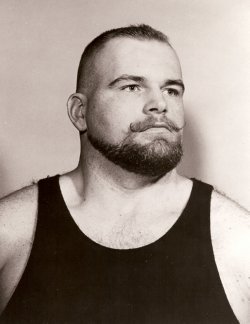
Karl Von Albers.
“It was still hot enough in those days that I could get by with it. The only trouble was I don’t speak German, and it was quite a thing to go through,” said Albers. “That worked for me quite well.”
The Miller connection never left him, as he switched from gimmick to gimmick. In Montreal, later in his career, Albers was billed as Von Albers Miller, and Count von Albers was another name.
Through all his years wrestling, Albers moved his family with him. He and his wife, Retta, have been together 60 years, and have three children, Gus, Amie (AJ), and Ed Jr.
In 1961, having made a good living in Texas, and spent way too much money returning to California in their trailer, the Albers decided it was time to settle down.
One last call convinced Albers that he made the right decision.
Guy Brunetti was a part of the famed Brunettis tag team and had taken over the wrestling office in Salt Lake City, Utah. He called his old friend Albers and about coming to work.
“I was fat and out of shape, and [Brunetti] was kind enough to tell me about the guy who had dropped dead in the ring up there about two months ago or something. He said, ‘Are you going to be next?’ I said, ‘Well, no.’ He said, ‘Then get the hell out or get in shape.’ And I got out. I almost attribute him to saving my life, because I was, hell, I was weighing 360 pounds, and right now I weigh 240.”
So in 1961, Albers was done with wrestling. He only recently retired from his second career of real estate.
“When I decided to get into something, being academically deprived, I had to look for something and I had some alternatives,” he said, listing car sales or owning a bar.
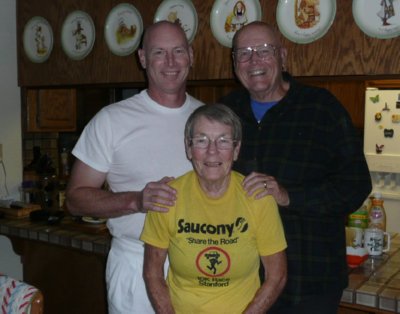
Ed Albers, right, poses with his wife, Retta, and one son, Gus.
Instead, Albers went back to school to get licensed to sell real estate. A year later, having served his apprenticeship, he was on his own.
While there was some recognition factor from his wrestling career, Albers said that the real strength came from his comfort in front of a crowd.
“I became the President of the California Association of Realtors in 1995. I had to make speeches to a couple thousand people. It doesn’t bother me. I was that way all my life, my adult life,” he said. Two of his sons went into real estate as well.
Out of wrestling more than 50 years, Albers confessed that he enjoyed the trip down memory lane.
He hadn’t forgotten how to pitch either.
“Make me look good! I want to have another match!”
RELATED LINK
- June 6, 2016: Danny Miller passes away at age 84
Greg Oliver hunted for Ed Albers while writing up the entry on the Miller Brothers for The Pro Wrestling Hall of Fame: The Tag Teams (written with Steve Johnson) but did not find Albers until recently, thanks to Vince Evans, who wrote The Destroyer’s book, Masked Decisions: The Triangular Life of Dick ‘The Destroyer’ ‘Doctor X’ Beyer; From American Athlete to International Icon.

